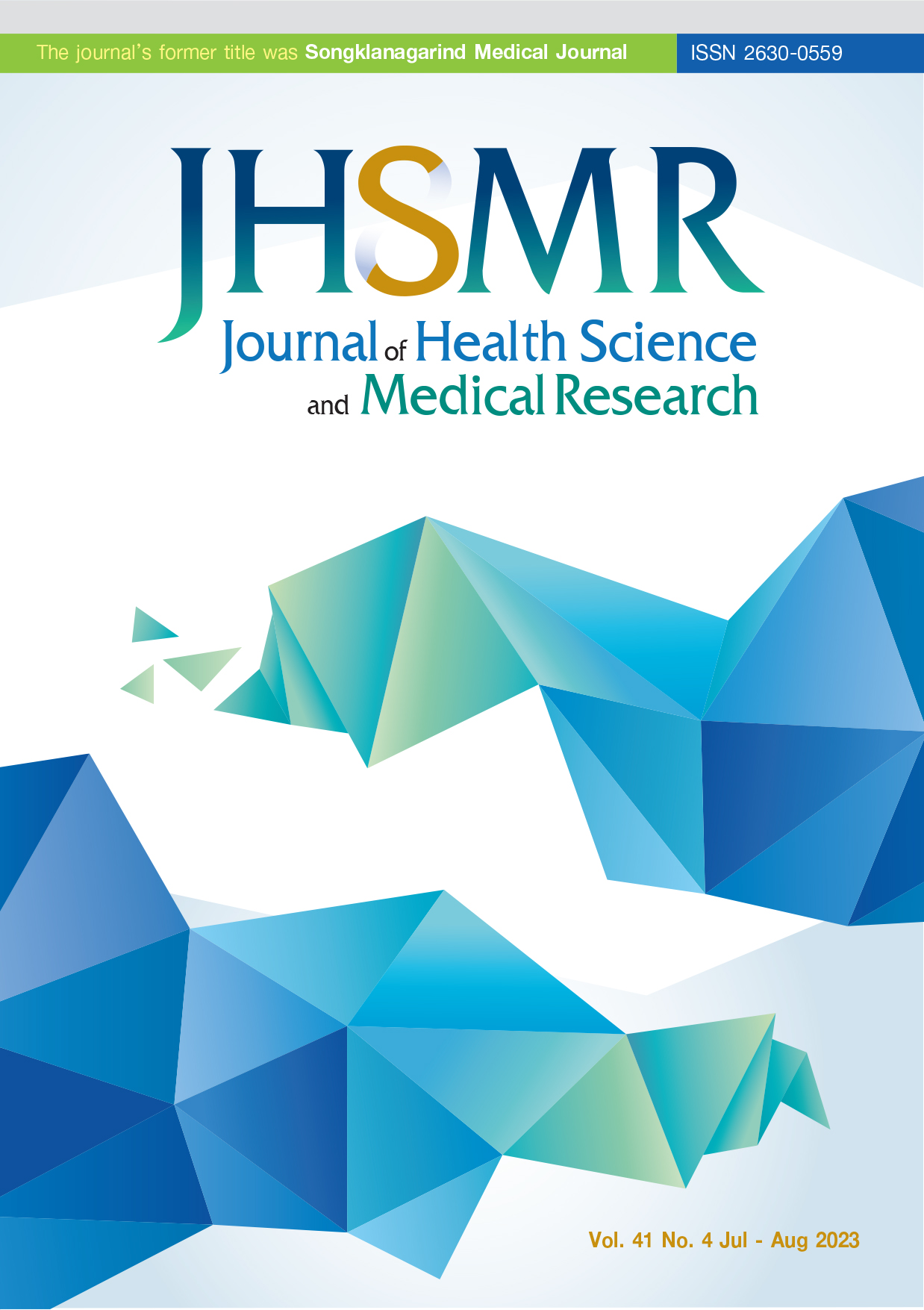Outcomes of Telepharmacy on Asthma Control at Ratchaburi Hospital
DOI:
https://doi.org/10.31584/jhsmr.2023928Keywords:
asthma control, inhalation technique, satisfaction, telepharmacyAbstract
Objective: This study aimed to assess clinical, humanistic and economic outcomes of telepharmacy in asthma patients.
Material and Methods: A quasi-experimental research design, with one-group pretest-posttest, was conducted to study telepharmacy. This real-time pharmaceutical care using communication technology was conducted in 29 asthma patients, over 12 weeks. Clinical outcomes were evaluated; including, asthma control, drug-related problems, adherence to use of inhaled corticosteroids (ICS), ICS-side effects, emergency room visits and hospitalizations due to acute exacerbation. Patient satisfaction was used to assess humanistic outcomes, and cost-saving was used to assess economic outcomes.
Results: Clinical outcomes showed statistically significant improvement in the number of well-controlled patients; increasing from 34.48% to 89.66% (p-value<0.01). ICS adherence improved from the mean percentage of number of times patients forgot to use ICS; which decreased from 5.86±18.67 to 0.21±0.74 (p-value<0.01). The mean number of drug-related problems decreased from 1.45±0.91 to 0.21±0.41 (p-value<0.01), and the mean number of ICS-side effects decreased from 0.66±0.72 to 0.14±0.44 (p-value<0.01). A total of 51.72 % of patients also required additional advice on inhaler techniques by a pharmacist. The mean number of emergency room visits and hospitalizations, due to acute exacerbation, decreased to zero by the end of the study. Humanistic outcomes revealed that patient satisfaction was at the ‘very satisfactory’ level (4.82±0.27 out of 5.00), and economic outcomes found that patients could save 49.99±34.90% compared to usual care.
Conclusion: This study shows that patients receiving telepharmacy have better outcomes in ICS adherence and asthma control, can prevent future risks (acute exacerbation, ICS-side effects), save costs and were very satisfied with telepharmacy overall.
References
Masoli M, Fabian D, Holt S, Beasley R. The global burden of asthma: executive summary of the GINA dissemination committee report. Allergy 2004;59:469-78.
Alexander E, Butler CD, Darr A, Jenkins MT, Long RD, Shipman CJ, et al. ASHP statement on telepharmacy. Am J Health Syst Pharm 2017;74:e236-41.
Li H, Zheng S, Liu F, Liu W, Zhao R. Fighting against COVID-19: Innovative strategies for clinical pharmacists. Res Social Adm Pharm 2021;17:1813-8.
Sankaranarayanan J, Murante LJ, Moffett LM. A retrospective evaluation of remote pharmacist interventions in a telepharmacy service model using a conceptual framework. Telemed JE Health 2014;20:893-902.
Brown W, Scott D, Friesner D, Schmitz T. Impact of Telepharmacy services as a way to increase access to asthma care. J Asthma 2017;54:961-7.
Ho I, Nielsen L, Jacobsgaard H, Salmasi H, Pottegård A. Chat-based Telepharmacy in Denmark: design and early results. Int J Pharm Pract 2015;23:61-6.
Rebello KE, Gosian J, Salow M, Sweeney P, Rudolph JL, Driver JA. The rural pill program: a postdischarge telepharmacy intervention for rural veterans. J Rural Health 2017;33:332-9.
Panek M, Mokros Ł, Pietras T, Kuna P. The epidemiology of asthma and its comorbidities in Poland-health problems of patients with severe asthma as evidenced in the Province of Lodz. Respir Med 2016;112:31-8.
Liu L, Fang J. Study on potential factors of patient satisfaction: based on exploratory factor analysis. Patient Prefer Adherence 2019;13:1983-94.
The Pharmacy Council of Thailand. Standard and developing telepharmacy. Statement of Thai Pharmacy Council (56/2563). Nonthaburi: The Pharmacy Council of Thailand; 2020;1-3.
Global Initiative for Asthma [homepage on the internet]. Bethesda: Global Initiative for Asthma; c2021 [cited 2021 Jun 9]. Global Strategy for Asthma Management and Prevention (2021 update). Available from: https://ginasthma.org/wp-content/uploads/2021/05/GINA-Main-Report-2021-V2-WMS.pdf.
Global Initiative for Asthma [homepage on the internet]. Bethesda: Global Initiative for Asthma; c2022 [cited 2022 Mar 7]. Global Strategy for Asthma Management and Prevention (2022 update). Available from: https://.ginasthma.org/wp-content/uploads/2022/05/GINA-Main-Report-2022-FINAL-22-05-03-WMS.pdf.
Wibowo, Astutik N, Luhung M. The correlation of anxiety with oral candidiasis on elderly In Pan gtesti Nursing Home Lawang. JKM 2019;4:96-102.
Young HN, Havican SN, Griesbach S, Thorpe JM, Chewning BA, Sorkness CA. Patient and phaRmacist telephonic encounters (PARTE) in an underserved rural patient population with asthma: results of a pilot study. Telemed J E Health 2012;18:427-33.
Adnan M, Karim S, Khan S, Al Wabel N. Comparative evaluation of metered-dose inhaler technique demonstration among community pharmacists in Al Qassim and Al-Ahsa region, Saudi-Arabia. Saudi Pharm J 2015;23:138-42.
Lavorini F, Magnan A, Dubus JC, Voshaar T, Corbetta L, Broeders M, et al. Effect of incorrect use of dry powder inhalers on management of patients with asthma and COPD. Respir Med 2008;102:593-604.
Lenney J, Innes JA, Crompton GK. Inappropriate inhaler use: assessment of use and patient preference of seven inhalation devices. EDICI. Respir Med 2000;94:496-500.
Bynum A, Hopkins D, Thomas A, Copeland N, Irwin C. The effect of Telepharmacy counseling on metered-dose inhaler technique among adolescents with asthma in rural Arkansas. Telemed JE Health 2001;7:207-17.
Downloads
Published
How to Cite
Issue
Section
License

This work is licensed under a Creative Commons Attribution-NonCommercial-NoDerivatives 4.0 International License.
























